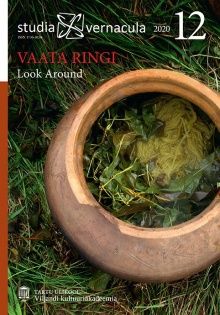Kõik värviks: Eestis kasvanud taimedest saadud värvid tekstiilil / All for colours: dyes from plants growing in Estonia on textile
DOI:
https://doi.org/10.12697/sv.2020.12.154-197Abstract
The research carried out during practical work at the Department of Textile Design of the Estonian Academy of Arts focuses on the acquisition of plant and alternative synthetic textile dyes in Estonian weather conditions in the context of textile printing and dyeing. The aim is to study the effect of plant dyes on textiles, by modifying different variables. As the result of testing, the author wanted to select more intensive plants and techniques, which withstand at least a first warm washing, and which could be studied further via a more systematic experimenting and testing.
In order to get multiple results at once, the majority of tests in fact comprise 12 tests, the results of which are presented on one page, including 12 samples of dye and the initial information about plants and procedures. A collection of dye samples comprises 132 test sheets, and presents the practical results of the research. All practical tests are documented with written descriptions compiled as an annex to the test sheets; some tests are also photographed.
It was observed how the dyeing results depend upon different conditions, e.g. the time of collecting plants, the dyeing process, the dyed textile fibres or the acidity of the solution. In order to fix the dye in textile different methods were applied, and the impact of temperature, time, different tanning substances, water and oxygen on the tone of the dye and its intensity was studied. Most samples of dyes have been washed in water at least 50 °C warm and ironed at a minimum of 200 °C after the dyeing process.
The author searched for possible sources of natural dyes in Estonia, taking into account the local tradition of natural dyes, and also exploring the options of introducing species not so well known as dyeing plants. The author cultivated plants for testing and collected species widespread in nature. The author discusses environmental problems connected with collecting and growing the plants, such as moving in nature and the hazard of the expansion of invasive non-native species on the local richness of species.
The choice of plants for this research paper is based on several different principles, which typically occur when searching for a possible source of dye. Based on the courses of thought, the author divides the plants used into eight theme groups with conditional names is as follows: ‘Primeval’, ‘Exotic’, ‘Weeds’, ‘Name shows the destiny’, ‘Compost’, ‘Minor relatives’, ‘Plants with beautiful colour’ and ‘Two-in-one’.
Common bright colours, which tolerated washing in warm water but needed technological improvement for increased light-resistance could be mentioned, e.g. the Dyer’s woad giving the blue dye, the Northern bedstraw giving red tones, Safflower that gives pink and yellow tones. Many plants gave warm brown tones. Among technologies, the most promising proved to be Joy Boutrup’s technique for reserve printing, during which the sodium alginate printed on the cloth is transferred into unsolvable form.
Biological tanning substances, renewable energy like solar power, and the use of a high temperature by extending the low dyeing time and bacterial fermentation dyeing might be some further steps in the development of sustainable dyeing processes. Finding low-cost production dyeing plants among weeds, the restricted use of non-native species, and of plant residue of food industry and other sectors would be a valuable and sustainable source of dye.
Key words: dyeing with plants, natural dyes, dye plants, textile printing, printing techniques, tannins

